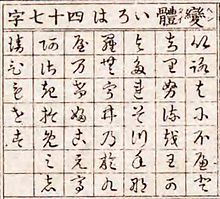Hentaigana
You can help expand this article with text translated from the corresponding article in Japanese. (August 2021) Click [show] for important translation instructions.
|
| Hentaigana | |
|---|---|
 | |
| Script type | |
Time period | c. 800 – 1900 CE; minor use at present |
| Languages | Japanese |
| Related scripts | |
Parent systems | |
Sister systems | Katakana, Hiragana |
| ISO 15924 | |
| ISO 15924 | Hira (410), Hiragana |
| Unicode | |
Unicode alias | Hiragana |
| |
 |
| Japanese writing |
|---|
| Components |
| Uses |
| Transliteration |
In the Japanese writing system, hentaigana (変体仮名, 変体がな, Japanese pronunciation: [hentaiɡana] or [hentaꜜiɡana], lit. "variant kana")[a] are variant forms of hiragana.[2]
Description[edit]
Today, among the hiragana glyphs, those not used in school education since 1900 are called "hentaigana".
Originally, hiragana had several forms for a single sound. For example, nowadays, the hiragana reading "ha" has only one form, "は". However, until the Meiji era (1868–1912), it was written in a variety of forms, including the following: ![]() ,
, ![]() and
and ![]() . As a result of the artificial and authoritarian selection of hiragana glyphs, variant kana is not used much in Japan today, but it is still used in limited situations such as signboards, calligraphy, place names, and personal names.[3]
. As a result of the artificial and authoritarian selection of hiragana glyphs, variant kana is not used much in Japan today, but it is still used in limited situations such as signboards, calligraphy, place names, and personal names.[3]
History[edit]


Hiragana, the main Japanese syllabic writing system, derived from cursive form of man'yōgana, a system where Chinese ideograms (kanji) were used to write sounds without regard to their meaning. Originally, the same syllable (more precisely, mora) could be represented by several more-or-less interchangeable kanji, or different cursive styles of the same kanji. However, the 1900 script reform[4][5] determined that only one specific character be used for each mora, with the rest being called hentaigana ("variant characters").
The 1900 standard included the hiragana ゐ, ゑ, and を, which historically stood for the phonetically distinct moras /wi/, /we/, and /wo/ but are currently pronounced as /i/, /e/, and /o/, identically to い, え, and お. The を kana is still commonly used in the Japanese writing system, instead of お, for the direct object particle /-o/. These characters were deprecated by the 1946 spelling reform.[6]
Hentaigana is still used occasionally today in some contexts, such as store signs and logos, to achieve the "old-fashioned" or "traditional" look.
Katakana has variant forms, too. For example, ![]() (ネ) and
(ネ) and ![]() (ヰ).[7] However, katakana's variant forms are fewer than hiragana's ones. Katakana's choices of man'yōgana segments had stabilized early on and established – with few exceptions – an unambiguous phonemic orthography (one symbol per sound) long before the 1900 script regularization.[8]
(ヰ).[7] However, katakana's variant forms are fewer than hiragana's ones. Katakana's choices of man'yōgana segments had stabilized early on and established – with few exceptions – an unambiguous phonemic orthography (one symbol per sound) long before the 1900 script regularization.[8]
Standardized hentaigana[edit]
Prior to the proposal which led to the inclusion of hentaigana in Unicode 10.0, they were already standardized into a list by Mojikiban, part of the Japanese Information-technology Promotion Agency (IPA).[9]
| a | i | u | e | o | |
|---|---|---|---|---|---|
| ∅ | あ(安) | い(以) | う(宇) | え(衣) | お(於) |
| 𛀂(安)
𛀅(惡) 𛀃(愛) 𛀄(阿) |
𛀆(以)
𛀇(伊) 𛀈(意) 𛀉(移) |
𛀊(宇)
𛀋(宇) 𛀌(憂) 𛀍(有) 𛀎(雲) |
𛀁(江)
𛀏(盈) 𛀐(縁) 𛀑(衣) 𛀒(衣) 𛀓(要) |
𛀔(於)
𛀕(於) 𛀖(隱) | |
| k | か(加) | き(幾) | く(久) | け(計) | こ(己) |
| 𛀗(佳)
𛀘(加) 𛀙(可) 𛀚(可) 𛀛(嘉) 𛀢(家) 𛀜(我) 𛀝(歟) 𛀞(賀) 𛀟(閑) 𛀠(香) 𛀡(駕) |
𛀣(喜)[10]
𛀤(幾) 𛀥(幾) 𛀦(支) 𛀻(期) 𛀧(木) 𛀨(祈) 𛀩(貴) 𛀪(起) |
𛀫(久)
𛀬(久) 𛀭(九) 𛀮(供) 𛀯(倶) 𛀰(具) 𛀱(求) |
𛀳(介)
𛀲(介) 𛀢(家) 𛀴(希) 𛀵(氣) 𛀶(計) 𛀷(遣) |
𛀸(古)
𛂘(子) 𛀹(故) 𛀻(期) 𛀺(許) | |
| s | さ(左) | し(之) | す(寸) | せ(世) | そ(曾) |
| 𛀼(乍)
𛀽(佐) 𛀾(佐) 𛀿(左) 𛁀(差) 𛁁(散) 𛁂(斜) 𛁃(沙) |
𛁄(之)
𛁅(之) 𛁆(事) 𛁇(四) 𛁈(志) 𛁉(新) |
𛁊(受)
𛁋(壽) 𛁌(數) 𛁍(數) 𛁎(春) 𛁏(春) 𛁐(須) 𛁑(須) |
𛁒(世)
𛁓(世) 𛁔(世) 𛁕(勢) 𛁖(聲) |
𛁗(所)
𛁘(所) 𛁙(曾) 𛁚(曾) 𛁛(楚) 𛁜(蘇) 𛁝(處) | |
| t | た(太) | ち(知) | つ(川) | て(天) | と(止) |
| 𛁞(堂)
𛁟(多) 𛁠(多) 𛁡(當) |
𛁢(千)
𛁣(地) 𛁤(智) 𛁥(知) 𛁦(知) 𛁧(致) 𛁨(遲) |
𛁩(川)
𛁪(川) 𛁫(津) 𛁬(都) 𛁭(徒) |
𛁮(亭)
𛁯(低) 𛁰(傳) 𛁱(天) 𛁲(天) 𛁳(天) 𛁴(帝) 𛁵(弖) 𛁶(轉) 𛂎(而) |
𛁷(土)
𛁸(度) 𛁹(東) 𛁺(登) 𛁻(登) 𛁼(砥) 𛁽(等) 𛁭(徒) | |
| n | な(奈) | に(仁) | ぬ(奴) | ね(祢) | の(乃) |
| 𛁾(南)
𛁿(名) 𛂀(奈) 𛂁(奈) 𛂂(奈) 𛂃(菜) 𛂄(那) 𛂅(那) 𛂆(難) |
𛂇(丹)
𛂈(二) 𛂉(仁) 𛂊(兒) 𛂋(爾) 𛂌(爾) 𛂍(耳) 𛂎(而) |
𛂏(努)
𛂐(奴) 𛂑(怒) |
𛂒(年)
𛂓(年) 𛂔(年) 𛂕(根) 𛂖(熱) 𛂗(禰) 𛂘(子) |
𛂙(乃)
𛂚(濃) 𛂛(能) 𛂜(能) 𛂝(農) | |
| h | は(波) | ひ(比) | ふ(不) | へ(部) | ほ(保) |
| 𛂞(八)
𛂟(半) 𛂠(婆) 𛂡(波) 𛂢(盤) 𛂣(盤) 𛂤(破) 𛂥(者) 𛂦(者) 𛂧(葉) 𛂨(頗) |
𛂩(悲)
𛂪(日) 𛂫(比) 𛂬(避) 𛂭(非) 𛂮(飛) 𛂯(飛) |
𛂰(不)
𛂱(婦) 𛂲(布) |
𛂳(倍)
𛂴(弊) 𛂵(弊) 𛂶(遍) 𛂷(邊) 𛂸(邊) 𛂹(部) |
𛂺(保)
𛂻(保) 𛂼(報) 𛂽(奉) 𛂾(寶) 𛂿(本) 𛃀(本) 𛃁(豊) | |
| m | ま(末) | み(美) | む(武) | め(女) | も(毛) |
| 𛃂(万)
𛃃(末) 𛃄(末) 𛃅(滿) 𛃆(滿) 𛃇(萬) 𛃈(麻) 𛃖(馬) |
𛃉(三)
𛃊(微) 𛃋(美) 𛃌(美) 𛃍(美) 𛃎(見) 𛃏(身) |
𛃐(武)
𛃑(無) 𛃒(牟) 𛃓(舞) 𛄝(无) 𛄞(无) |
𛃔(免)
𛃕(面) 𛃖(馬) |
𛃗(母)
𛃘(毛) 𛃙(毛) 𛃚(毛) 𛃛(茂) 𛃜(裳) 𛄝(无) 𛄞(无) | |
| y | や(也) | 𛀆(以) | ゆ(由) | 𛀁(江) | よ(与) |
| 𛃝(也)
𛃞(也) 𛃟(屋) 𛃠(耶) 𛃡(耶) 𛃢(夜) |
𛀆(以) | 𛃣(游)
𛃤(由) 𛃥(由) 𛃦(遊) |
𛀁(江) | 𛃧(代)
𛃨(余) 𛃩(與) 𛃪(與) 𛃫(與) 𛃬(餘) 𛃢(夜) | |
| r | ら(良) | り(利) | る(留) | れ(礼) | ろ(呂) |
| 𛃭(羅)
𛃮(良) 𛃯(良) 𛃰(良) 𛁽(等) |
𛃱(利)
𛃲(利) 𛃳(李) 𛃴(梨) 𛃵(理) 𛃶(里) 𛃷(離) |
𛃸(流)
𛃹(留) 𛃺(留) 𛃻(留) 𛃼(累) 𛃽(類) |
𛃾(禮)
𛃿(礼) 𛄀(連) 𛄁(麗) |
𛄂(呂)
𛄃(呂) 𛄄(婁) 𛄅(樓) 𛄆(路) 𛄇(露) | |
| w | わ(和) | ゐ(為) | 𛄟(汙)[11] | ゑ(恵) | を(遠) |
| 𛄈(倭)
𛄉(和) 𛄊(和) 𛄋(王) 𛄌(王) |
𛄍(井)
𛄎(井) 𛄏(居) 𛄐(爲) 𛄑(遺) |
𛄒(惠)
𛄓(衞) 𛄔(衞) 𛄕(衞) |
𛄖(乎)
𛄗(乎) 𛄘(尾) 𛄙(緒) 𛄚(越) 𛄛(遠) 𛄜(遠) 𛀅(惡) | ||
| n' | ん(无) | ||||
| 𛄝(无)
𛄞(无) |
To view hentaigana, special fonts need to be installed that support Hentaigana such as
- BabelStone Han
- IPA MJ Mincho Version 5.01 and later
- Hanazono Mincho
- Hanazono Mincho AFDKO
- UniHentaiKana
The glyph for example Hiragana wu (𛄟) also needs a special font to display such as
Sources of hentaigana [edit]
Hentaigana are adapted from the reduced and cursive forms of the following man’yōgana (kanji) characters.[12] Source characters for the kana are not repeated below for hentaigana even when there are alternative glyphs; some uncertain.
| Hiragana | Katakana | Hentaigana | ||
|---|---|---|---|---|
| Ø | あ | 安 | 阿 | 悪亜愛 |
| い | 以 | 伊 | 意移異夷 | |
| う | 宇 | 有雲憂羽于 | ||
| え | 衣 | 江 | 要盈得縁延 | |
| お | 於 | 隱 | ||
| K | か | 加 | 閑可我駕賀歌哥香家嘉歟謌佳 | |
| き | 機幾 | 支起貴喜祈季木 | ||
| く | 久 | 倶具求九供 | ||
| け | 計 | 介 | 遣氣 (気) 希个 | |
| こ | 己 | 許故古期興子 | ||
| S | さ | 左 | 散 | 佐斜沙差乍狭 |
| し | 之 | 志四新事斯師 | ||
| す | 寸 | 須 | 春數壽爪 | |
| せ | 世 | 勢聲瀬 | ||
| そ | 曽 (曾) | 所楚處蘇 | ||
| T | た | 太 | 多 | 當堂田佗 |
| ち | 知 | 千 | 地遲治致智池馳 | |
| つ | 川 | 川州 | 徒都津頭 | |
| て | 天 | 停亭轉弖帝傳偏氐低 | ||
| と | 止 | 東登度等斗刀戸土 | ||
| N | な | 奈 | 那難名南菜 | |
| に | 仁 | 仁二 | 爾耳二児丹尼而 | |
| ぬ | 奴 | 怒努駑 | ||
| ね | 祢 (禰) | 年子熱念音根寢 | ||
| の | 乃 | 能濃農廼野 | ||
| H | は | 波 | 八 | 者盤半葉頗婆芳羽破 |
| ひ | 比 | 日飛悲非火避備妣 | ||
| ふ | 不 | 婦布風 | ||
| へ | 部 | 旁倍遍弊邊閉敝幣反變 (変) 辨經 | ||
| ほ | 保 | 寶 (宝) 本報奉穂 | ||
| M | ま | 末 | 万満萬眞馬間麻摩漫 | |
| み | 美 | 三 | 見微身民 | |
| む | 武 | 牟 | 無 (无) 舞務夢 | |
| め | 女 | 免面馬目妻 | ||
| も | 毛 | 母裳茂蒙藻 | ||
| Y | や | 也 | 夜耶屋哉 | |
| 𛀆 | 以 | |||
| ゆ | 由 | 遊游 | ||
| 𛀁 | 江 | 衣 | ||
| よ | 與(与) | 代餘余世夜 | ||
| R | ら | 良 | 羅蘭落等 | |
| り | 利 | 梨里離理李 | ||
| る | 留 | 流 | 累類 | |
| れ | 礼(禮) | 連麗豊 (豐) | ||
| ろ | 呂 | 婁 (娄) 樓路露侶廬魯論 | ||
| W | わ | 和 | 王倭 | |
| ゐ | 為 | 井 | 居委遺 | |
| 𛄟 | 汙 | 宇 | ||
| ゑ | 恵 (惠) | 衛 (衞) 彗 | ||
| を | 遠 | 乎 | 越尾緒 | |
| 'N | ん | 无 | 尓 (爾) | |
In Unicode[edit]
286 hentaigana characters are included in the Unicode Standard in the Kana Supplement and Kana Extended-A blocks. One character was added to Unicode version 6.0 in 2010, 𛀁 (U+1B001 HIRAGANA LETTER ARCHAIC YE which has the formal alias HENTAIGANA LETTER E-1), and the remaining 285 hentaigana characters were added in Unicode version 10.0 in June 2017.[13]
The Unicode block for Kana Supplement is U+1B000–U+1B0FF:
| Kana Supplement[1] Official Unicode Consortium code chart (PDF) | ||||||||||||||||
| 0 | 1 | 2 | 3 | 4 | 5 | 6 | 7 | 8 | 9 | A | B | C | D | E | F | |
| U+1B00x | 𛀀 | 𛀁 | 𛀂 | 𛀃 | 𛀄 | 𛀅 | 𛀆 | 𛀇 | 𛀈 | 𛀉 | 𛀊 | 𛀋 | 𛀌 | 𛀍 | 𛀎 | 𛀏 |
| U+1B01x | 𛀐 | 𛀑 | 𛀒 | 𛀓 | 𛀔 | 𛀕 | 𛀖 | 𛀗 | 𛀘 | 𛀙 | 𛀚 | 𛀛 | 𛀜 | 𛀝 | 𛀞 | 𛀟 |
| U+1B02x | 𛀠 | 𛀡 | 𛀢 | 𛀣 | 𛀤 | 𛀥 | 𛀦 | 𛀧 | 𛀨 | 𛀩 | 𛀪 | 𛀫 | 𛀬 | 𛀭 | 𛀮 | 𛀯 |
| U+1B03x | 𛀰 | 𛀱 | 𛀲 | 𛀳 | 𛀴 | 𛀵 | 𛀶 | 𛀷 | 𛀸 | 𛀹 | 𛀺 | 𛀻 | 𛀼 | 𛀽 | 𛀾 | 𛀿 |
| U+1B04x | 𛁀 | 𛁁 | 𛁂 | 𛁃 | 𛁄 | 𛁅 | 𛁆 | 𛁇 | 𛁈 | 𛁉 | 𛁊 | 𛁋 | 𛁌 | 𛁍 | 𛁎 | 𛁏 |
| U+1B05x | 𛁐 | 𛁑 | 𛁒 | 𛁓 | 𛁔 | 𛁕 | 𛁖 | 𛁗 | 𛁘 | 𛁙 | 𛁚 | 𛁛 | 𛁜 | 𛁝 | 𛁞 | 𛁟 |
| U+1B06x | 𛁠 | 𛁡 | 𛁢 | 𛁣 | 𛁤 | 𛁥 | 𛁦 | 𛁧 | 𛁨 | 𛁩 | 𛁪 | 𛁫 | 𛁬 | 𛁭 | 𛁮 | 𛁯 |
| U+1B07x | 𛁰 | 𛁱 | 𛁲 | 𛁳 | 𛁴 | 𛁵 | 𛁶 | 𛁷 | 𛁸 | 𛁹 | 𛁺 | 𛁻 | 𛁼 | 𛁽 | 𛁾 | 𛁿 |
| U+1B08x | 𛂀 | 𛂁 | 𛂂 | 𛂃 | 𛂄 | 𛂅 | 𛂆 | 𛂇 | 𛂈 | 𛂉 | 𛂊 | 𛂋 | 𛂌 | 𛂍 | 𛂎 | 𛂏 |
| U+1B09x | 𛂐 | 𛂑 | 𛂒 | 𛂓 | 𛂔 | 𛂕 | 𛂖 | 𛂗 | 𛂘 | 𛂙 | 𛂚 | 𛂛 | 𛂜 | 𛂝 | 𛂞 | 𛂟 |
| U+1B0Ax | 𛂠 | 𛂡 | 𛂢 | 𛂣 | 𛂤 | 𛂥 | 𛂦 | 𛂧 | 𛂨 | 𛂩 | 𛂪 | 𛂫 | 𛂬 | 𛂭 | 𛂮 | 𛂯 |
| U+1B0Bx | 𛂰 | 𛂱 | 𛂲 | 𛂳 | 𛂴 | 𛂵 | 𛂶 | 𛂷 | 𛂸 | 𛂹 | 𛂺 | 𛂻 | 𛂼 | 𛂽 | 𛂾 | 𛂿 |
| U+1B0Cx | 𛃀 | 𛃁 | 𛃂 | 𛃃 | 𛃄 | 𛃅 | 𛃆 | 𛃇 | 𛃈 | 𛃉 | 𛃊 | 𛃋 | 𛃌 | 𛃍 | 𛃎 | 𛃏 |
| U+1B0Dx | 𛃐 | 𛃑 | 𛃒 | 𛃓 | 𛃔 | 𛃕 | 𛃖 | 𛃗 | 𛃘 | 𛃙 | 𛃚 | 𛃛 | 𛃜 | 𛃝 | 𛃞 | 𛃟 |
| U+1B0Ex | 𛃠 | 𛃡 | 𛃢 | 𛃣 | 𛃤 | 𛃥 | 𛃦 | 𛃧 | 𛃨 | 𛃩 | 𛃪 | 𛃫 | 𛃬 | 𛃭 | 𛃮 | 𛃯 |
| U+1B0Fx | 𛃰 | 𛃱 | 𛃲 | 𛃳 | 𛃴 | 𛃵 | 𛃶 | 𛃷 | 𛃸 | 𛃹 | 𛃺 | 𛃻 | 𛃼 | 𛃽 | 𛃾 | 𛃿 |
Notes
| ||||||||||||||||
The Unicode block for Kana Extended-A is U+1B100–U+1B12F:
| Kana Extended-A[1][2] Official Unicode Consortium code chart (PDF) | ||||||||||||||||
| 0 | 1 | 2 | 3 | 4 | 5 | 6 | 7 | 8 | 9 | A | B | C | D | E | F | |
| U+1B10x | 𛄀 | 𛄁 | 𛄂 | 𛄃 | 𛄄 | 𛄅 | 𛄆 | 𛄇 | 𛄈 | 𛄉 | 𛄊 | 𛄋 | 𛄌 | 𛄍 | 𛄎 | 𛄏 |
| U+1B11x | 𛄐 | 𛄑 | 𛄒 | 𛄓 | 𛄔 | 𛄕 | 𛄖 | 𛄗 | 𛄘 | 𛄙 | 𛄚 | 𛄛 | 𛄜 | 𛄝 | 𛄞 | 𛄟 |
| U+1B12x | 𛄠 | 𛄡 | 𛄢 | |||||||||||||
| Notes | ||||||||||||||||
Modern usage[edit]

Hentaigana are considered obsolete, but a few marginal uses remain. For example, otemoto (chopsticks), is written in hentaigana on some wrappers and many soba shops use hentaigana to spell kisoba on their signs. (See also: "Ye Olde" for "the old" on English signs.)
Hentaigana are used in some formal handwritten documents, particularly in certificates issued by classical Japanese cultural groups (e.g., martial art schools, etiquette schools, religious study groups, etc.). Also, they are occasionally used in reproductions of classic Japanese texts, akin to the use of blackletter in English and other Germanic languages to give an archaic flair. Modern poems may be composed and printed in hentaigana for visual effect.[14]
However, most Japanese people are unable to read hentaigana nowadays, only recognizing a few from their common use in shop signs, or figuring them out from context.
Gallery[edit]
Some of the following hentaigana are cursive forms of the same kanji as their standard hiragana counterparts, but simplified differently. Others descend from unrelated kanji that represent the same sound.
-
以(い)i
-
江(え)e
-
於(お)o
-
可(か)ka, ga
-
起(き)ki, gi
-
古(こ)ko, go
-
志(し)shi, ji
-
春(す)su, zu
-
多(た)ta, da
-
奈(な)na
-
能(の)no
-
者(は)ha, ba
-
由(ゆ)yu
-
連(れ)re
-
路(ろ)ro
-
王(わ)wa
See also[edit]
Notes[edit]
References[edit]
- ^ 笹原宏之, 横山詔, Eric Long (2003). 現代日本の異体字. 三省堂. pp. 35–36. ISBN 4-385-36112-6.
{{cite book}}: CS1 maint: multiple names: authors list (link) - ^ 小項目事典,ASCII.jpデジタル用語辞典,世界大百科事典内言及, 精選版 日本国語大辞典,デジタル大辞泉,日本大百科全書(ニッポニカ),ブリタニカ国際大百科事典. "異体字(いたいじ)とは? 意味や使い方". コトバンク (in Japanese). Retrieved 2024-02-01.
{{cite web}}: CS1 maint: multiple names: authors list (link) - ^ #築島1981、pp.352-353。
- ^ Regulations on the Enforcement of the Elementary School Ordinance (小学校令施行規則, Shōgakkō-rei Shikōkisoku), 1900 revision
- ^ Frellesvig, Bjarke (2010-07-29). A History of the Japanese Language. Cambridge University Press. p. 160. ISBN 978-1-139-48880-8.
- ^ Seeley, Christopher (2000). A History of Writing in Japan. Honolulu: University of Hawai'i Press. ISBN 9780824822170.
- ^ 『小学略則教授法』「五十音図」
- ^ Tranter, Nicolas (2012). The Languages of Japan and Korea. Routledge. p. 218. ISBN 978-0-415-46287-7.
- ^ "Mj文字情報一覧表 変体仮名編". Archived from the original on 2018-09-29. Retrieved 2018-09-29.
- ^ "MJ文字情報一覧表 変体仮名編". mojikiban.ipa.go.jp. The Kanji 㐂 derived from the Hentaigana of 喜. Archived from the original on 2018-09-29. Retrieved 2018-11-19.
{{cite web}}: CS1 maint: others (link) - ^ Iannacone, Jake (2020). "Reply to The Origin of Hiragana /wu/ 平仮名のわ行うの字源に対する新たな発見"
- ^ 伊地知, 鉄男 (1966). 仮名変体集. 新典社.
- ^ "Unicode 10.0.0". Unicode Consortium. June 20, 2017. Retrieved June 21, 2017.
- ^ The Japan Interpreter. Center for Japanese Social and Political Studies. 1976. p. 395.
External links[edit]
- Chart of hentaigana calligraphy from O'Neill's A Reader of Handwritten Japanese Archived 2006-07-07 at the Wayback Machine
- A chart of hentaigana hosted by Jim Breen of the WWWJDIC
- Chart of kana from Engelbert Kaempfer circa 1693
- Hentaigana on signs (in Japanese)
- L2/15-239 Proposal for Japanese HENTAIGANA - Unicode















